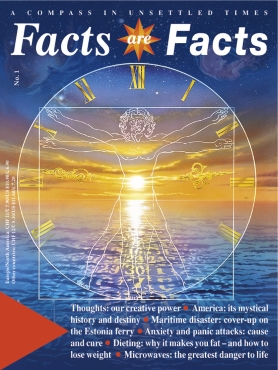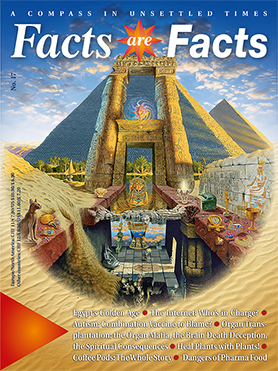Natural Catastrophes: No Man Is an Island Unto Himself
On December 26, 2004, a terrible sea quake and the resulting monster waves devastated the countries bordering the Indian Ocean. The toll is ever rising and will not stop at 24,000 deaths. But no matter how merciless this seems, even natural catastrophes are guided by a conscious intelligence for the wellbeing of the entire planet. For all of nature is permeated by the divine soul.
Let me ask a question: how many times does one have to hurl a hundred tree trunks into the air for them to fall from heaven in the form of a complete log cabin?
This question is by no means as foolish as it sounds. Everyone will naturally say that a log cabin could never become a reality in this way. But many people believe something even more improbable: namely that the universe and our earth with all its myriads of mutually sustaining life forms is a product of pure chance. They argue something like this: we were once fish who crawled onto land and then climbed out of the trees. Purely by chance, of course.
Although man has flown to the moon and has split the atom, he is still unable to produce a simple blade of grass - which should really make us ponder.
And whoever reduces love between two people to mere biochemical processes in the brain must ask why don't all men simultaneously fall in love with all women. The Siemens company made a similar error in a completely different field. They used powerful computers in an attempt to develop translation programs that could compete with human translators. Surely a logical approach, after all language is ultimately made up of a limited number of building blocks composed of letters. A simple matter for a supercomputer, one might think. Ultimately, however, the company wasted billions of marks with little to show for it.
For language is more than merely an accumulation of letters. The whole is always more than its constituent parts, and human consciousness cannot be reduced to bits and bytes. Nor can living nature be reduced to mere physical and chemical processes - although life admittedly manifests through chemistry and even more through physics in the material world.
We know from our everyday experience that the larger a company, the more complex is its structure. It has an administrative board and CEOs, departmental heads of all kinds and any number of field employees. Nature alone seems to be able to dispense entirely with 'employees'.
Really? Well, actually not. After all, it's not without reason that we say 'as above, so below' - 'as in heaven, so also on earth'. To return to our fictitious log cabin: it can become a reality only when the process is guided by an intelligent consciousness.
The same applies to our planet. For a cosmic intelligence ensouls this celestial body: mother earth. Some call her Gaia, although she prefers the name Lady Terra. This mighty and divine being is like the Chief Executive Officer of Earth Inc. Her employees are legion. And to make sure that everyone knows exactly what he has to do, nature too has superiors. Life does not function without a hierarchy, all political correctness notwithstanding.
Lady Terra's field employees are attired in the most diverse forms: flowers, grasses, bushes, trees, animals etc. Just because a sunflower differs somewhat from your face in appearance, it would be arrogant to assume that it was without intelligence or consciousness. Scientists such as Cleve Backster already proved scientifically decades ago that plants can feel and react to human thoughts and feelings. As early as 1966 Backster used a lie detector to measure the electrochemical reactions of plants.
He also discovered that blood samples stored hundreds of kilometres away from us continue to adapt their biochemistry exactly to the conditions of the blood in our body! Everything is connected, that's the nature of God. Or as the poet John Donne once said (1622): "No man is an Island, entire of it self".
A flutter of a butterfly's wing can trigger a tornado at the other end of the earth. Do I see you smiling? Do you know what a Hopi shaman said when he was asked why he was tickling a beetle lying on its back with a twig? "I will carry on annoying him until the rain clouds will be attracted by it."
If plants react to human emotions in the same way as water, why should the earth itself be unaffected by them - quite apart from the greenhouse gases and the rest of the garbage that we expect it to cope with every day? For the planetary body is the physical garment of Lady Terra. And exactly as we might get a fit of the shivers or have an abscess burst on our face, the earth organism must also submit to phases of cleaning. We experience this as earthquakes, tornadoes or floods.
Due to modern technology, man's destructive thoughts and feelings can spread out and multiply explosively over the entire globe, for instance via the medium of film. Scary Movie, Scream, Halloween, The Blair Witch Project are just a few of the film titles that sent shivers down the spines of millions of viewers. So it's hardly surprising that the earth needs to 'vomit' with increasing frequency?
Although the climate seems to be increasingly out of sync, this is by no means a chaotic process. Jesus is said to have calmed a storm on the Sea of Galillee. And the ancient Greeks believed in Zeus, the weather god of their mythology. Are these merely fairy tales? Or are there invisible nature beings that guide all the phenomena we can experience - and with whom we can communicate?
So we should not be too hasty in blaming God for natural catastrophes, but rather ask ourselves whether they might have been triggered by human behaviour.
Four tornadoes swept across the USA within just a few weeks last year, an occurrence unknown for over 120 years. Do we really think that we can incessantly abuse our precious planetary home to this degree without facing the consequences at some time? They are an inevitable response by the earth to secure the survival of this cosmic schoolroom in the long term. Tectonic tensions between continents, for example, do not always have purely physical causes.
Despite all this, God is merciful wherever He can be. And His servants keep the degree of destruction down to a minimum. Think, if you will, what would have happened if the recent sea quake would have taken place underneath highly populated areas instead of the middle of the Indian Ocean. Hundred of thousands of people could have died. It was the same regarding Hurricane Andrew, the most expensive tornado of all time: Had it passed only a hundred kilometres further south or east through Florida and Louisiana in 1992, the damage could have been four times as high. And the earthquake that struck Los Angeles on the early morning of January 17, 1994 to become the greatest natural catastrophe in American history with $30 billion worth of damage would have killed thousands if it had taken place only a few hours later. But even the death of thousands as a result of natural forces is not as tragic in the eyes of God as it might seem to those of us with a Christian heritage. After all, every human soul is immortal and returns innumerable times to earth - with a new physical body, a new name and with a new opportunity in life.
When nature raises her voice
The year 2004 saw an unusual accumulation of tropical tornadoes in the Atlantic and Pacific oceans. Thousands of people died in Haiti, and the material damage sustained in the USA reached a new record. In the Atlantic region alone, no fewer than eight hurricanes (with speeds of over 120 kilometres per hour) developed from a total of fourteen storms.
Half of them swept over various Caribbean islands in August and September and hit the American coast. The names Charley, Frances, Ivan and Jeanne are synonymous with dread for many people since then. The particularly hard-hit state of Florida mourned 113 deaths this year. But that is nothing compared with the toll taken by Hurricane Jeanne in Haiti alone: the subsequent floods and landslides cost the lives of over 2,000 people.
In 2004, the insured damage in the USA was estimated at $20 to 25 billion by re-insurer Swiss Re. But the damage sustained by the nation's economy is likely to be double that figure - an unprecedented sum.
An unusually large number of tornadoes also developed in the Pacific region. Japan was the main target, being struck by ten typhoons - another record! Provisional estimates suggest that the scale of damage amounted to six billion dollars.
Only a few days after Japan had been hit by the most destructive typhoon for a quarter of a century (almost 100 dead), a series of severe earthquakes and over 440 aftershocks rocked the island at the end of October 2004 even as the next typhoon was already approaching. Thousands were injured and over thirty killed in the heaviest toll since the Kobe earthquake. It could have been worse: experts estimate that a quake of the same strength striking the Tokyo metropolitan area would have meant some 7,000 deaths.
Large parts of Asia were particularly hard hit by floods last year. Experts spoke of extreme climatic conditions. In China alone, over 1,000 people had already fallen victim to the floods by mid-year.
In November 2004, two tropical storms - Muifa and Merbok - swept across the Philippines and cost more than 70 human lives. At the end of the same month, a severe earthquake shook the eastern parts of Indonesia and killed almost 20 people. And then, at Christmas, there was this sea quake in the Indian Ocean that claimed more than 24,000 deaths.






